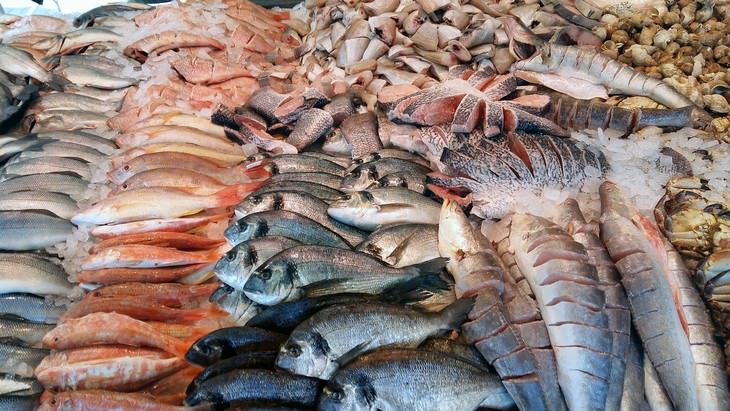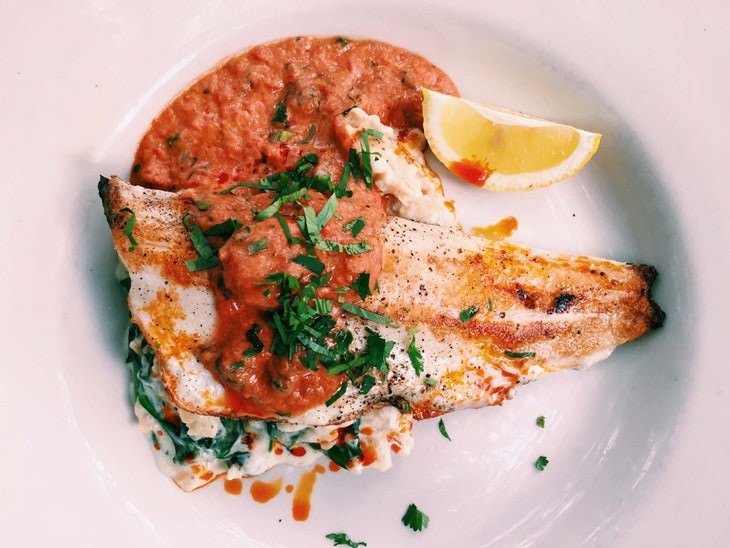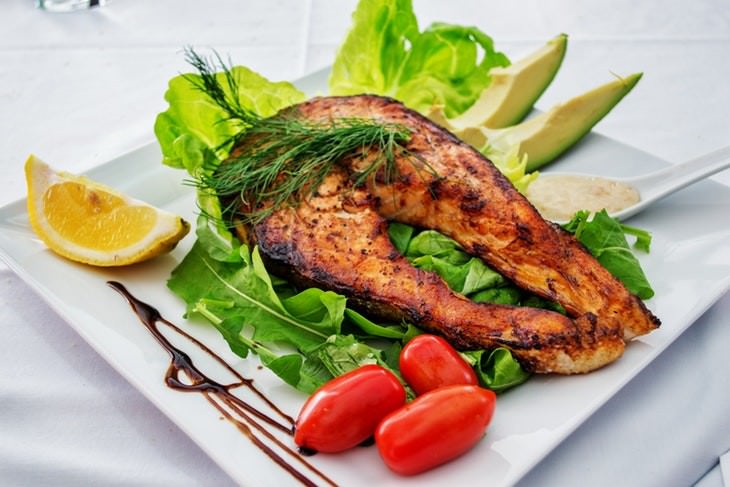

If you’re new to fish and you love a good juicy steak, tuna is your best bet. It’s considered a beginners fish, as it is already sold in large boneless and skinless chunks or steaks that need little to no prep before cooking. There are 2 kinds of tuna fish: yellowfin and bluefin tuna, with the first one usually sold in supermarkets and fish markets for grilling and searing, whereas the pricier bluefin tuna normally being used in sushi.
Preparation: grilling, searing, sushi.
How to select: look for an evenly-colored piece of tuna that has no brown spots and doesn’t look dry on the edges. The color can vary from pink to dark red.
How to cook: When grilled or pan-seared, tuna steaks are best when cooked to medium-rare or rare and subsequently coated with a sauce, as tuna can dry out very quickly, becoming a bit too tough. In sushi, it is consumed raw and thinly sliced.
2 No-Fail Methods of Preparing Tuna Steaks
If you want to experiment with new fish varieties and are ready to spend a little more on fish, try halibut. These are oceanic flatfish native to North America that have juicy, yet lean white flesh. It is usually sold filleted or cut in steaks.
Preparation: grilling, baking, ceviche.
How to select: If you’re going to bake or grill your halibut, make sure you have a cut with the skin on, as this will help you preserve the shape of the otherwise flakey and succulent fish. A fresh, high-quality halibut fillet is white and somewhat translucent, with no yellowness.
How to cook: Because of the mild taste and succulent, flaky texture, halibut tastes excellent with as little or as many spices, glazes, and sauces as you like, ranging from just a sprinkling of salt and pepper to a variety of herbs, lemon, honey glazes, etc. Halibut retains moisture well, too, so it’s difficult to overcook.
Honey and Lemon Halibut Fillet Recipe
If you want to expand your seafood palette, but aren’t ready to shell out a lot of cash, consider tilapia. It's cheap as chips and easily available, with the frozen ones being equally as tasty as the fresh ones thanks to its firm texture. It is most often sold in fillets, which have no bones.
However, preparing this fish can be a bit more work because it can sometimes have a somewhat earthy or muddy taste. Still, this disadvantage can be dealt with quite easily by learning how to choose and boost its taste with herbs and spices.

Preparation: pan-frying, marinades.
How to select: Search for pinkish-white, and not greyish cuts with a firm texture.
How to cook: Before cooking, rub your tilapia with fresh herbs, spices of your liking, or even sliced onions, and drizzle it liberally with lime or lemon juice, letting it sit in this marinade for 10-20 minutes. This will neutralize the earthy flavor.
A Simple Blackened Tilapia Recipe
Cod is a real multitasker, with its firm texture and delicate taste lending itself to a variety of preparations. This white fish can be affordable and is easily available in many varieties, such as hake, whiting, and pollock. Cod can be incorporated into cooked dishes, or can be pan-seared, fried or baked. It is sold either in fillets or cut into steaks depending on the size of the fish.
Preparation: stew, tacos, chowder.
How to select: As is the case with most white fish, you should stay away from yellowy cuts and look for a clean white color with a firm texture and fresh smell.
How to cook: Depending on your dish, you will have to cook it differently, but keep in mind that taking the skin off is a must, as its taste is not very appealing.
One of the most affordable members of the cod family is haddock, the kind of fish most commonly used in fish and chips. It shares the flavor and texture profile with cod, but it is extremely flaky and firm, which makes it great for deep-frying.
Preparation: deep-frying, pan-frying, baking.
How to select: Similarly to cod, opt for clear white fillets that hold their shape.
How to cook: When frying fish, don’t forget to pat it dry with a towel to make sure the breading sticks to the fish better and prevent any oil splatters.
Easy Pan-Fried Haddock Recipe
Considered one of the tastiest white fish varieties, snapper is juicy, yet firm, low in fat and very savory. By far the most popular kind is red snapper, which is easy to distinguish by its red hue. This fish is widely available in the United States and very popular. Snapper is often sold whole, mostly because it's most commonly grilled whole.
Preparation: grilled or roasted whole.
How to select: A fresh snapper has no fishy smell, has clear eyes and bright red gills when bought whole. If you're buying it already cut, the flesh should have a pinkish hue.
How to prepare: Snapper is very versatile and can be prepared or added to most dishes that call for fish. Grilling it whole is an easy and sure way to go, just don't forget to brush it liberally with oil to prevent it from sticking to the grill.
Creative Red Snapper and Vegetable Stew
The flaky light-pink Atlantic salmon is a staple, it’s what comes up in most people’s minds when someone says “fish”. This fatty, delicious fish is nearly impossible to cook wrong and it is as versatile as it is tasty and healthy. It is sold is a variety of cuts: steaks, fillets, and whole side cuts with the skin on. You simply cannot go wrong with salmon.
Preparation: grilling, baking, chowder, roasting.

How to select: Look for a vibrantly-colored piece of salmon with the color varying from bright pink to coral. The piece shouldn’t have any browning, signs of pieces separating from each other or spots. The skin should be silvery and smooth, not darker and curled up on the edges.
How to cook: Depending on your recipe, you will prepare your salmon differently, but do run your hand through the cut to make sure there are no bones and remove by pinching it with your hands if you find one.
How To Make the Crispiest Salmon Possible
If you’re looking for a cheaper stand-in for salmon, definitely opt for trout, especially rainbow or steelhead trout that has the same pinkish color salmon does but is less rich in fat. Both freshwater and oceanic varieties exist, with the freshwater ones having a milder taste and the ones that come from the ocean having a sweeter flavor that’s closer to salmon.
Preparation: grilling, baking, roasting, steaming.
How to select: The criteria are the same as salmon, with the option of choosing between freshwater and sea varieties.
How to cook: Lends itself to a variety of preparations, but make sure not to reheat any leftover trout, as the fat content of the fish oxidizes and gains an unpleasant smell. Instead, divide it into bite-sized chunks and add to a salad.
No-Fuss Baked Trout Recipe
Unlike the farmed Atlantic variety, wild Pacific salmon is leaner and somewhat drier in texture and has a much deeper red hue. It’s also often smaller than Atlantic salmon.
Preparation: curing, roasting, poaching.
How to select: Look for more sustainable certified varieties to prevent marine life depletion. Also, don't be alarmed to see a bright pink coloring, it's a natural color that the fish gain because they feed on crustaceans in the ocean.
How to cook: With Pacific salmon, you should cook it carefully and favor preparations that will prevent moisture loss, otherwise the results may be too stringy and not juicy, so the best thing you can do is cure Pacific salmon or roast it in a rich sauce. If you decide to bake it, however, do so at a lower temperature than Atlantic salmon, around 120°C (250°F).
How to Make Beautiful Beetroot-Cured Salmon